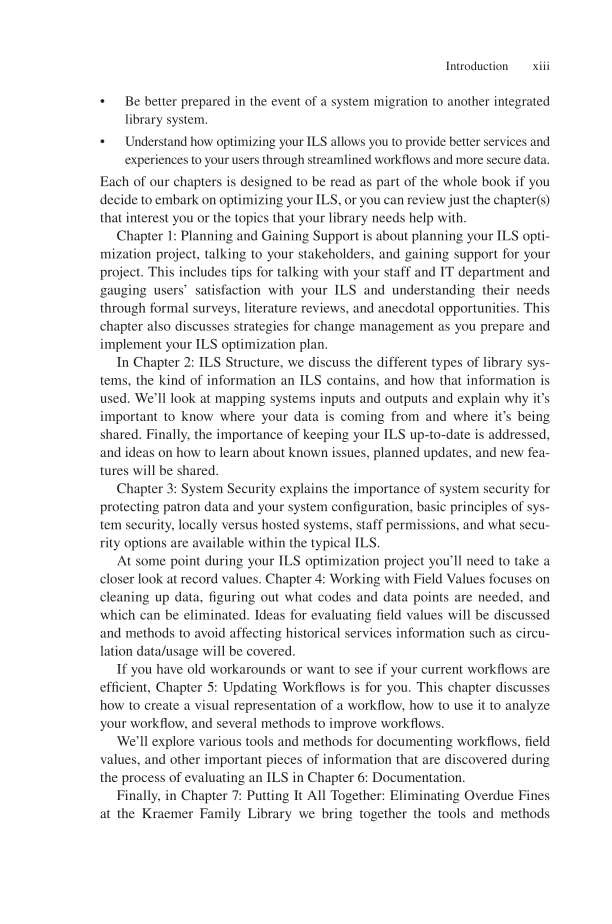Introduction xiii • Be better prepared in the event of a system migration to another integrated library system. • Understand how optimizing your ILS allows you to provide better services and experiences to your users through streamlined workflows and more secure data. Each of our chapters is designed to be read as part of the whole book if you decide to embark on optimizing your ILS, or you can review just the chapter(s) that interest you or the topics that your library needs help with. Chapter 1: Planning and Gaining Support is about planning your ILS opti- mization project, talking to your stakeholders, and gaining support for your project. This includes tips for talking with your staff and IT department and gauging users’ satisfaction with your ILS and understanding their needs through formal surveys, literature reviews, and anecdotal opportunities. This chapter also discusses strategies for change management as you prepare and implement your ILS optimization plan. In Chapter 2: ILS Structure, we discuss the different types of library sys- tems, the kind of information an ILS contains, and how that information is used. We’ll look at mapping systems inputs and outputs and explain why it’s important to know where your data is coming from and where it’s being shared. Finally, the importance of keeping your ILS up-to-date is addressed, and ideas on how to learn about known issues, planned updates, and new fea- tures will be shared. Chapter 3: System Security explains the importance of system security for protecting patron data and your system configuration, basic principles of sys- tem security, locally versus hosted systems, staff permissions, and what secu- rity options are available within the typical ILS. At some point during your ILS optimization project you’ll need to take a closer look at record values. Chapter 4: Working with Field Values focuses on cleaning up data, figuring out what codes and data points are needed, and which can be eliminated. Ideas for evaluating field values will be discussed and methods to avoid affecting historical services information such as circu- lation data/usage will be covered. If you have old workarounds or want to see if your current workflows are efficient, Chapter 5: Updating Workflows is for you. This chapter discusses how to create a visual representation of a workflow, how to use it to analyze your workflow, and several methods to improve workflows. We’ll explore various tools and methods for documenting workflows, field values, and other important pieces of information that are discovered during the process of evaluating an ILS in Chapter 6: Documentation. Finally, in Chapter 7: Putting It All Together: Eliminating Overdue Fines at the Kraemer Family Library we bring together the tools and methods
Document Details My Account Print multiple pages
Print
You have printed 0 times in the last 24 hours.
Your print count will reset on at .
You may print 0 more time(s) before then.
You may print a maximum of 0 pages at a time.





































































































































































